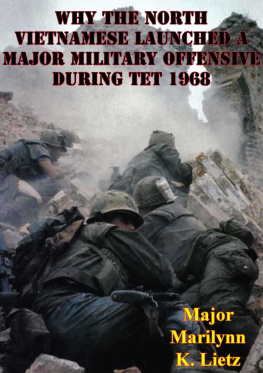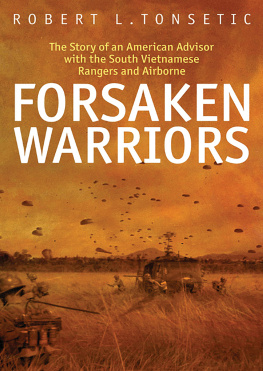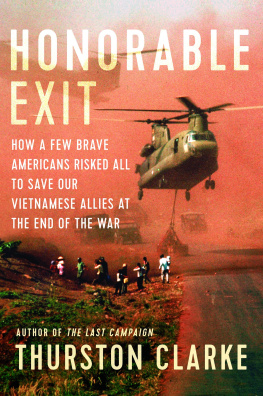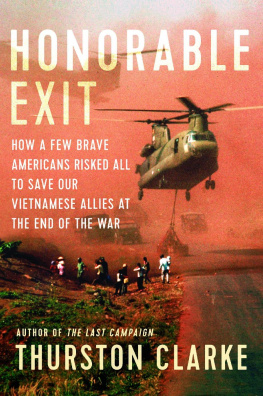
Please visit our website, www.garethstevens.com. For a free color catalog of all our high-quality books, call toll-free 1-800-542-2595 or fax 1-877-542-2596.
Library of Congress Cataloging-in-Publication Data
Samuels, Charlie.
The Tet Offensive / by Charlie Samuels.
p. cm. (Turning points in US military history)
Includes index.
ISBN 978-1-4824-0436-4 (pbk.)
ISBN 978-1-4824-0438-8 (6-pack)
ISBN 978-1-4824-0435-7 (library binding)
1. Tet Offensive, 1968 Juvenile literature. 2. Vietnam War, 1961-1975 Campaigns Juvenile literature. I. Samuels, Charlie, 1961-II. Title.
DS557.8.T4 S26 2014
959.704dc23
Published in 2014 by
Gareth Stevens Publishing
111 East 14th Street, Suite 349
New York, NY 10003
2014 Brown Bear Books Ltd
For Brown Bear Books Ltd:
Editorial Director: Lindsey Lowe
Managing Editor: Tim Cooke
Childrens Publisher: Anne ODaly
Design Manager: Keith Davis
Designer: Lynne Lennon
Picture Manager: Sophie Mortimer
Production Director: Alastair Gourlay
Picture Credits:
Front Cover: US National Archives
All images US National Archives except:
Robert Hunt Library: .
All Artworks Brown Bear Books Ltd
Brown Bear Books has made every attempt to contact the copyright holder. If you have any information please contact
All rights reserved. No part of this book may be reproduced, stored in a retrieval system, or transmitted in any form or by any means, electronic, mechanical, photocopying, recording, or otherwise, without the prior written permission of the copyright holder.
Manufactured in the United States of America
CPSIA compliance information: Batch #CW14GS. For further information contact Gareth Stevens, New York, New York at 1-800-542-2595.
CONTENTS
Introduction
Vietnam Divided
US Arrival in Vietnam
An Elusive Enemy
Americas Southern Allies
Westmorelands Plan
Battles of 19661967
The Siege of Khe Sanh
The Tet Offensive
The Battle for Saigon
The Battle for Hue
Impact on America
From Tet to Defeat
TIMELINE
GLOSSARY
FURTHER INFORMATION
INDEX
INTRODUCTION
T he Tet Offensive of January 30, 1968, marked the turning point of the Vietnam War. It was a major assault by the North Vietnamese Army and Vietcong guerrillas against US and South Vietnamese positions in cities throughout South Vietnam. After the first shock, the Americans and their allies fought back and defeated the attacks. Despite the US victory, however, the Tet Offensive confirmed the growing fear that the United States would ultimately lose the war.
Unexpected Resistance
US ground forces had been in Vietnam since spring 1965 to support South Vietnam in its war against its communist neighbor. Many Americans expected an easy victory. But US troops found themselves facing an enemy whose tactics took away the advantages of the modern US Army.
American Opinion
The North Vietnamese government was prepared to suffer huge losses, because it had loyal support from its population. Many Americans, however, were not clear about why US soldiers were losing their lives in a faraway land. As they watched the Tet Offensive on their TV screens, it became clear to many that the United States could not win the war. It was time to find an alternative solution to end the fighting.

US B-52 Stratofortresses drop bombs on enemy positions, but bombing did not make the North Vietnamese stop fighting.
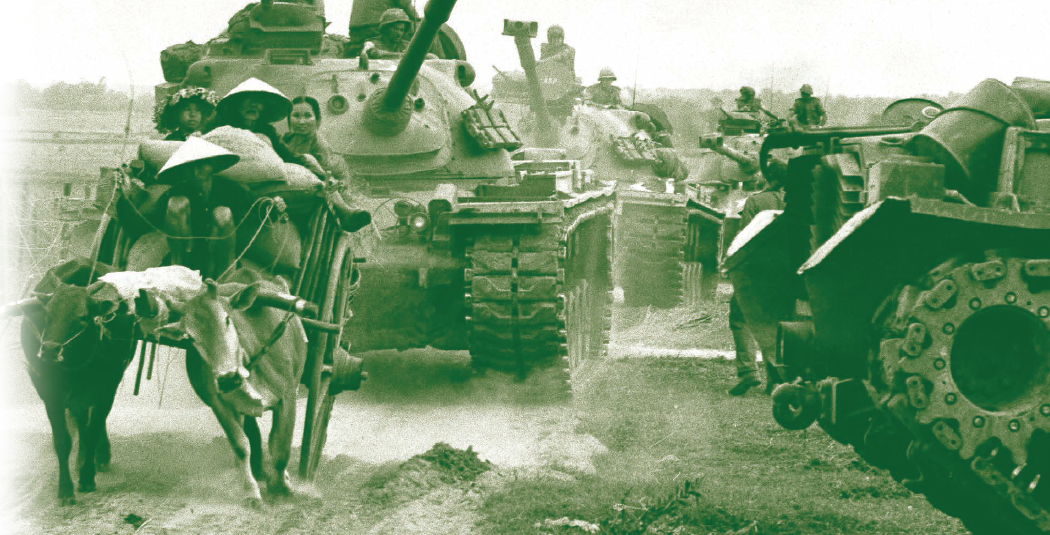
US tanks are held up behind a farmers ox cart. The war was mainly fought in the countryside with no fixed front lines.
Vietnam Divided
The modern-day country of Vietnam, in Southeast Asia, was known as Indochina in the 19th century, when it was conquered by the French. The French were eager to exploit Vietnams natural resources, which included gold, silver, and precious stones, as well as silk, spices, and rice. In 1887, the French made Vietnam a colony of their empire, called French Indochina.

Vietminh troops parade through North Vietnams capital, Hanoi, in January 1955, after the country became independent.

A French artillery crew shells Vietminh positions outside the base during the siege at Dien Bien Phu.
By the end of the 19th century, up to 50,000 French people lived in Indochina. They treated the local people badly, which led to frequent uprisings against the unpopular rulers.
World War II
When war began in Europe in 1939, Japan took over Indochina. Its rule lasted only until its defeat in the war in 1945. But local communists, led by Ho Chi Minh, did not want the French to resume their control. The Vietnamese were tired of being ruled by foreigners. They backed Ho Chi Minh, who declared himself president of Vietnam in August 1945.
DIEN BIEN PHU
Dien Bien Phu was a French base behind enemy lines in North Vietnam, 10 miles (16 km) from the border with Laos. Some 16,000 French troops were stationed there. On March 20, 1954, the North Vietnamese laid siege to the base. For six weeks, the French were unable to get supplies into the base, while the men there came under constant shelling. On May 7, 1954, the French were forced to surrender. More than 2,200 French troops had died.
In October 1945 French troops returned to Vietnam. They resumed colonial rule of the southern part of the country, but Ho Chi Minh and the communists controlled the north. With the backing of China and the Soviet Union, Ho created a communist state. In January 1946 he became president of the Democratic Republic of Vietnam, or North Vietnam.
The First Indochina War
The south was initially called the Republic of Cochin-China; it later became South Vietnam. The French and the communists both wanted to control the whole country. The First Indochina War broke out between the French and the Vietminh, Hos nationalist movement, in December 1946.

South Vietnamese leader Ngo Dinh Diem (left) joins French officials as the French surrender Vietnam in September 1954.

Vietminh troops take control of the town of Haiphong in early 1955, after Vietnam was officially split into two countries.
Defeat for France
After eight years of fighting, the French eventually lost the war. The French army surrendered after a long siege of their base at Dien Bien Phu in 1954. Vietnam was divided ocially into the North and the South. The backing of the Soviet Union and China made North Vietnam the stronger country of the two. The US government was worried the communists would take over their southern neighbor. It sent special forces advisors to help the South Vietnamese avoid a possible attack. The first US troops arrived on January 1, 1955.
Next page





